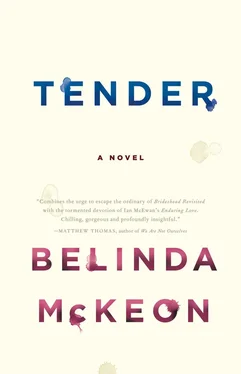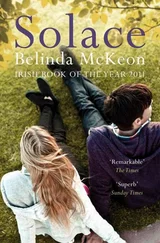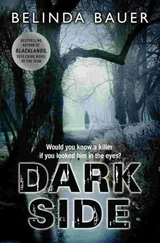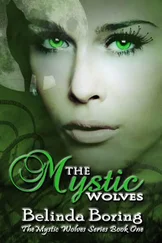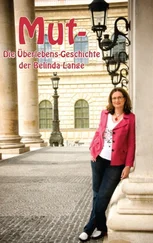“Oh, no, it’s OK,” Catherine said, shaking her head. “I’d prefer just to look at them head-on, if you know what I mean. I always prefer to do it that way at first.”
“No problem,” said Alice, and she put the list back on the desk. “Well, the show starts in the next room and continues into the back room,” she said, pointing. “I hope you like it.”
All of the faces greeted her; all of the staring men. Young, most of them. Striking, all of them, each in their own way, but then that was James; that was what James did. And then, not all of them were staring, she realized; some of them were looking right out at the viewer, a sort of reckoning, but some of them were refusing, or simply not feeling obliged, to meet the viewer’s eye; glancing to the side or to the ground, to something other, something out of frame. Or maybe to nothing at all; maybe only to thought, to where a thought led.
Shaven-headed, the first of them — from the entrance, she moved to the right, to the man with the buzz cut and the vaguely disapproving mouth, the touch of bloodshot at the sides of his eyes. She did not like him, she decided; she was, somehow, afraid of him. Ridiculous, but that was her reaction, and she had learned, in all of these years walking around galleries, to realize that the reaction was the thing really worth looking at, was the place where the interesting, uncomfortable stuff was to be found.
The next boy was beautiful, the boy with the wax in his hair; more wax than he needed, but it did nothing to interfere with his beauty; nothing could. He was probably twenty-five, she thought, but he looked younger, maybe because he looked startled; maybe because the camera had caught him by surprise, clicking at him as he busied himself with something that could not be seen, something on the other side of the rock on which he was seated; it was a summer day, and he and James had been somewhere, a park, a mountain, somewhere, and James had taken up his camera and the boy’s head had turned. A bag at his feet. No trace of wariness in his eyes.
Smoking, the next guy. Not young. Standing at what looked like a bus stop. A check shirt, the sleeves rolled up. Blond hair on his arms. His fingers were stubby; the nails were flecked with something: maybe paint. He did not look like someone waiting. His eyes looking out to the street. He looked like someone who had not decided whether, when the bus did come, he would be getting on.
Long-haired and weary-looking, the fourth one. Dark shadows under his eyes. This was another formal portrait, like the first one; there was nothing in the background, there was no everyday clutter, no everyday world. There were no props. The wall behind him bare. His shirt blue, his chin dimpled, his impatience seeming already to have propelled him out of the shot. He hugged himself. He wanted to be away.
Five looked Irish, she thought. Some kind of embarrassment in his gaze; some kind of awkwardness. Ah, Jaysus, James, the photo might have been called, she thought, laughing to herself; but he was handsome, the dark eyebrows, the high forehead, the shirt collars askew.
Six was black, stretched out on what looked like a beach towel, though fully clothed. She glanced around, seeing another black guy across the way, and felt immediately ashamed of herself — counting, as though it was something she should even be noticing, but the reaction was the whole point, she reminded herself, and anyway, nobody needed to know. Alice, for example, coming smiling towards her now, an iPad in her hands; Alice did not need to know that Catherine had looked around and had counted the black faces, and nor did anyone else.
“Superb, aren’t they?” Alice said. She looked around the walls and nodded, as if in agreement with herself. “I love the one of Christian,” she said, and she pointed towards the door.
“Oh,” Catherine said. “I hadn’t even noticed.”
“The pieces go from left to right, really,” Alice said, “but I guess it doesn’t matter which way you look at them.” She gave a short laugh. “As long as you look at them.”
Catherine said nothing. She was crossing to the photo of Christian, which had obviously been taken on the same day as the one she had already seen; he was wearing the same clothes, the same sleeveless T-shirt and cargo shorts, and there were his dark curls, and there were his full lips, and there was the light tan on his skin, the tan he had brought with him, surely, to Carrigfinn; you did not get a tan in a place like Carrigfinn. This photo had been taken outside, out in the greenness and the warmth which it had been possible only to glimpse over his shoulder in the other one; at his back were the rusted bars of a gate, a gate into a meadow, and in the meadow the grass was high, the sunshine was flooding it; it glowed like a field made of light.
“That must have been June,” Catherine said in a murmur. “They haven’t knocked that field.”
“Knocked the—?” Alice was saying from beside her now, sounding confused.
“It’s nothing,” Catherine said. “Just a detail I noticed. It’s a beautiful photo.”
“ So beautiful,” Alice said. “I mean, the look on Christian’s face. The way you can tell he’s just about to smile. And the way he’s leaning back onto that railing — something about the, sort of, playfulness of that, I love it.”
“Yeah,” Catherine said. “I love it too.”
“And I love the one of you.”
Catherine stared. “The—?”
“You haven’t seen it yet?” Alice said, walking towards the second room, and beckoning Catherine to follow her.
“I’m sorry,” Catherine said, her voice closing on itself. “There’s a photo of me?”
“Oh yeah,” Alice said, glancing back. “James didn’t tell you?”
She shook her head. “No.”
“Fuck!” Alice said, putting a hand to her mouth. She immediately looked horrified. “Oh my God, I’m sorry. I shouldn’t have said that. It’s just — I assumed you knew — I didn’t realize it was a—”
Catherine was already walking past her.
“It doesn’t even look like you, really,” Alice said weakly, as Catherine passed into the next room, as Catherine caught her breath.
It was a photo of a photo. A photo of a photo in a bright blue wooden frame, standing on a bookshelf, books behind it; you could read the spines, if you wanted to, which Catherine did not, just at this moment; Catherine did not know, just at this moment, what she wanted to do, whether it was to stare at this small square of what had once been herself, or to turn her back on it and run. The photo had been taken at the kitchen table in Baggot Street that first day; not the first day, not the day they had met, but the day after they had first been together, the day after everything had changed. She was slouching, and straggle-haired — she was hungover — wearing her old flannel shirt, the shirt she had loved, the shirt she had bought second-hand from a market stall near St. Stephen’s Green the summer she was sixteen. In her hands was the Gary Larson mug Ellen had given her one Christmas, the one with the joke about Moses parting the waters, and the table was a mess in front of her: milk cartons, and tea towels, and the yellow plastic bowl for which nobody ever remembered to get any fruit. Somebody’s empty Marlboro packet, crushed as though it had been stepped on. A newspaper; a newspaper, by then already ridiculously out of date.
She was staring right into the lens.
“1998,” Alice read from her iPad. “Wow.” She cleared her throat. “I love the shirt you’re wearing.”
“Thanks,” Catherine managed.
“From which I did not know,” Alice said. “Nice.”
“What?” Catherine said, turning sharply.
Читать дальше
